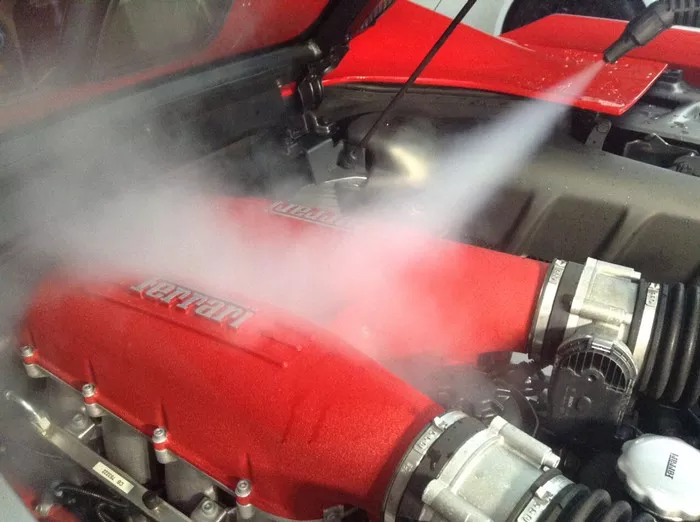Cleaning a car engine might seem like a daunting task, but using a steam washer can make the process more efficient and eco-friendly. Steam cleaning is gentle on engine components, highly effective at removing grime, and uses significantly less water than traditional methods. However, achieving the best results without damaging your engine requires proper technique and attention to detail.
In this guide, we’ll cover the benefits of using a steam cleaner, essential safety precautions, step-by-step instructions for preparing and cleaning your engine bay, and tips for drying and finishing touches. By following these guidelines, you can ensure a safe, effective, and thorough engine cleaning.
See also: How to Deep Clean Carpets with Steam Cleaning
Safety Precautions
Before diving into the cleaning process, it’s crucial to take several safety precautions to protect both you and your vehicle.
First and foremost, always consult your car’s manual before starting any cleaning procedure. The manual provides specific information about your engine bay’s layout and identifies sensitive components that require special care.
Identifying and protecting sensitive electrical components is critical. Use plastic bags or electrical tape to cover parts such as the alternator, battery terminals, and any exposed wiring. This step prevents moisture from causing electrical malfunctions.
It’s also important to avoid using high-pressure steam cleaners. While steam is effective for cleaning, excessive pressure can damage delicate components, such as seals, gaskets, and electrical connectors. Opt for a steam cleaner with adjustable pressure settings to control the steam intensity.
Preparing the Engine Bay
Proper preparation is key to a successful engine cleaning session. Start by letting the engine cool completely. Cleaning a hot engine can lead to burns and may cause plastic parts to warp due to sudden temperature changes.
Once the engine is cool, remove any loose debris, such as leaves, twigs, and dust, from the engine bay. This step ensures that loose particles don’t get in the way during the cleaning process.
Protecting the surrounding areas of the engine bay, like the fenders and windshield, is optional but recommended. Use towels or plastic sheeting to cover these areas, preventing steam and dirt from spreading beyond the engine bay.
Steam Cleaning Process
Pre-clean (optional)
For engines with significant grease buildup, a pre-cleaning step using a degreaser can be beneficial. Select a degreaser suitable for automotive use and apply it to the greasy areas of the engine bay. Follow the product instructions regarding the dwell time, typically allowing the degreaser to sit for a few minutes to break down the grease.
After the degreaser has had time to work, use a brush to scrub particularly stubborn areas. This step can make the subsequent steam cleaning more effective by loosening tough grime.
Steam Cleaning
When you’re ready to start steam cleaning, it’s essential to have a clear plan and proceed methodically. Begin cleaning from the top of the engine bay and work your way down. This approach prevents dirty runoff from re-soiling already cleaned areas.
Use a steam cleaner with an adjustable nozzle to control the steam pressure. Focus on greasy areas, but avoid prolonged exposure to steam in one spot to prevent damaging components. Instead, move the nozzle in a steady, sweeping motion.
For tight spaces and intricate parts of the engine, use different nozzle attachments designed for precision cleaning. A soft brush can also be used to agitate grime that the steam has loosened, ensuring a thorough clean.
Throughout the process, be mindful of the steam cleaner’s pressure and heat settings. Too much pressure or prolonged exposure can harm sensitive parts, so it’s better to use a moderate setting and keep the nozzle moving.
See also: When to Unleash the Power of Steam
Drying and Finishing Touches
After steam cleaning, it’s crucial to dry the engine bay thoroughly. Use microfiber towels to absorb excess moisture, preventing water spots and corrosion. Pay special attention to areas where water might collect, such as around the battery and electrical components.
Allow the engine bay to air dry completely before starting the car. This step ensures that any remaining moisture evaporates, reducing the risk of electrical issues.
For a professional finish, consider applying a protectant to rubber hoses and belts. This optional step not only enhances the appearance of your engine bay but also helps protect these components from cracking and drying out.
Conclusion
Steam cleaning your car engine can be an efficient, eco-friendly way to maintain your vehicle’s performance and appearance. By following proper techniques and safety precautions, you can avoid damage and achieve a pristine engine bay.
Key takeaways include consulting your car’s manual, protecting sensitive components, using a steam cleaner with adjustable pressure, and ensuring thorough drying. If your engine is heavily soiled or you’re unsure about any steps, don’t hesitate to consult a professional. With careful attention to detail, you can keep your car’s engine clean and running smoothly.

